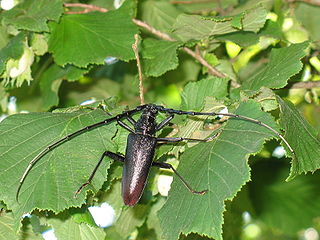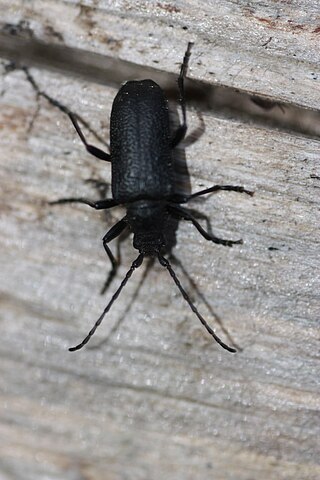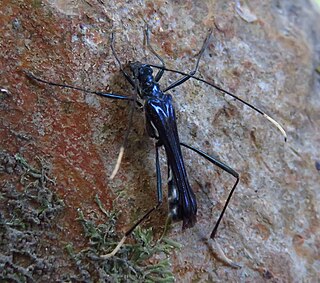
The longhorn beetles (Cerambycidae), also known as long-horned or longicorns, are a large family of beetles, with over 35,000 species described.

Cerambyx is a genus of beetles in the family Cerambycidae. They are commonly known as capricorn beetles, as their strong, stout and curved antennae, each segment of which flares towards the tip, are reminiscent of the horns of an Alpine Ibex or "capricorn".

Apterotoxitiades is a genus in the longhorn beetle family Cerambycidae. There are at least two described species in Apterotoxitiades, found in South Africa.

Dorcasominae is a subfamily in the longhorn beetle family Cerambycidae. There are about 14 genera and more than 30 described species in Dorcasominae, found mainly in Asia and Africa. These genera are sometimes considered members of the tribe Dorcasomini, which would be the only tribe of this subfamily. This classification is in accordance with the TITAN Cerambycidae database, Catalogue of Life, and Photographic Catalog of the Cerambycidae of the Old World. It is similar to that of Bouchard et al. in "Family-group names in Coleoptera", 2011.

Neanthophylax is a genus in the longhorn beetle family Cerambycidae. There are at least four described species in Neanthophylax.

Stenorhopalus is a genus in the longhorn beetle family Cerambycidae. There are about 16 described species in Stenorhopalus, found in Chile and Argentina.

Ulochaetes is a genus in the longhorn beetle family Cerambycidae. There are at least two described species in Ulochaetes.

Bimiini is a tribe of beetles in the subfamily Cerambycinae, containing the following genera and species:

Criodion is a genus of Long-Horned Beetles in the beetle family Cerambycidae. There are about 11 described species in Criodion.
Plocaederus is a genus of Long-Horned Beetles in the beetle family Cerambycidae. This genus has a single species, Plocaederus bellator. It is known from the South American countries Brazil, Ecuador, Guyana, French Guiana, Paraguay, and Suriname.

Sphallotrichus is a genus of beetles in the family Cerambycidae, containing the following species:

Curtomerus is a genus in the longhorn beetle family Cerambycidae. There are about 9 described species in Curtomerus.
Aleiphaquilon is a genus of Long-Horned Beetles in the beetle family Cerambycidae. There are about nine described species in Aleiphaquilon, found in South America.
Fregolia is a genus of longhorn beetles in the family Cerambycidae. This genus has a single species, Fregolia listropteroides. It is found in Argentina, Brazil, and Paraguay.
Marauna is a genus of longhorn beetles in the family Cerambycidae. There are at least three described species in Marauna.
Myrmeocorus is a genus of longhorn beetles in the family Cerambycidae. This genus has a single species, Myrmeocorus allodapus. It is found in Brazil.
Neocoridolon is a genus of longhorn beetles in the family Cerambycidae. This genus has a single species, Neocoridolon borgmeieri. It is found in Brazil.
Neocorus is a genus of longhorn beetles in the family Cerambycidae. There are at least three described species in Neocorus.

Dorcasomus is a genus in the longhorn beetle family Cerambycidae. There are about nine described species in Dorcasomus, found in Africa.
Kudekanye is a genus in the longhorn beetle family Cerambycidae. This genus has a single species, Kudekanye suidafrika, found in South Africa.











